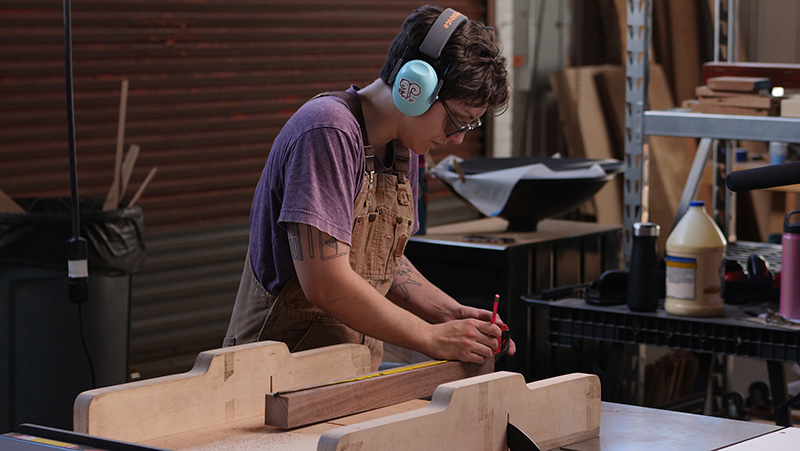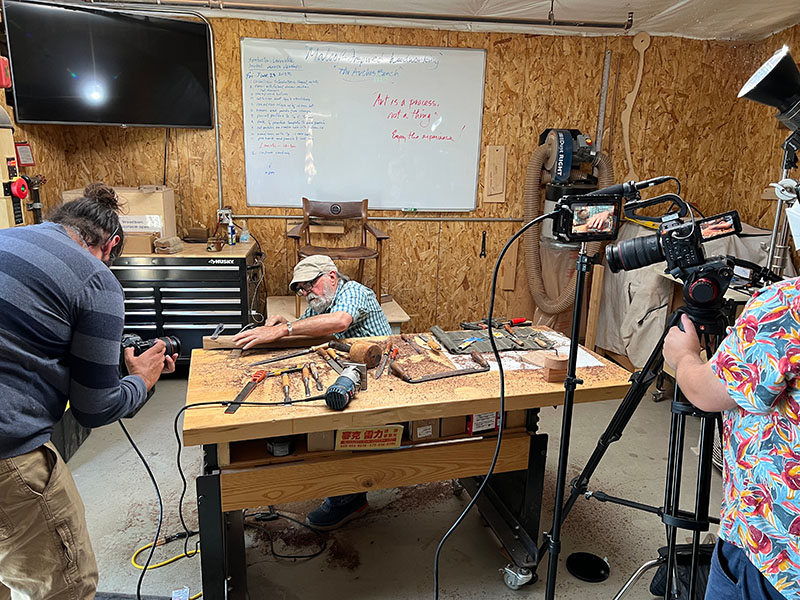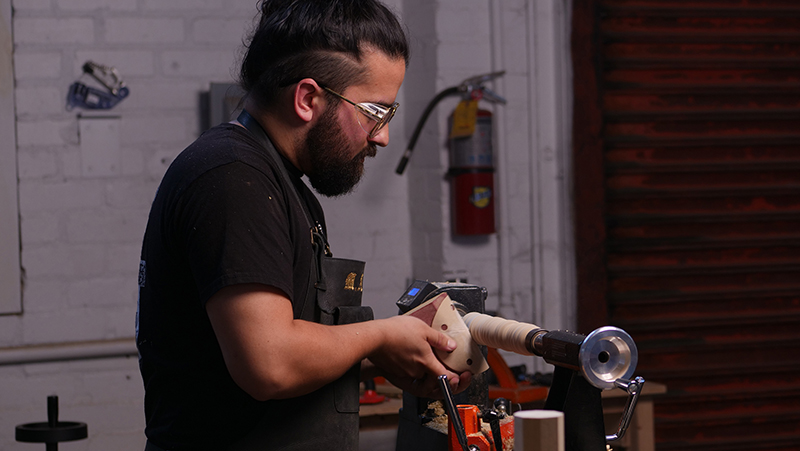Understanding Craft: A New Digital Tool Debuts
Click on images to enlarge them and view captions.
Three years in the making, Craft in America is launching the first ever Craft Video Dictionary (CVD), thanks to support from the Decorative Arts Trust’s inaugural Prize for Excellence and Innovation. The CVD (accessible at craftvideodictionary.org) is a free online resource that gives the public direct, close-up views of the craft processes and techniques behind the decorative arts. Instead of words and images, CVD definitions are conveyed via video. Clear and concise, these segments are edited to focus strictly on the artists’ movements and the transformation of their materials. By providing an intimate lens into the artist’s studio, each video entry is an accurate look at how the objects in our world come to be and the skills handcraft really entails.
The CVD consists of techniques demonstrated by artists with expertise across the spectrum of the crafts and decorative arts. Ceramics, metal, wood, fiber, glass, and other materials are among the represented media. Terms range from sgraffito to shaping hot glass and from coiling fiber to fullering. Each video features an artist shaping their work through methods that are historic and also very much alive. These videos provide a bridge to the past and shed light on how people have created objects over the centuries. Craft is a continuum that spans time and connects cultures.
The roll-out of this new reference tool includes an initial batch of 100 video definitions, and 100 additional videos will be posted later this year. The first collection of videos begins to flesh out the specifics of art and craft making across materials and media, and there is so much more to be recorded. The CVD has the potential to include hundreds of additional videos featuring the work of artists from across the country and beyond.
Throughout time, craft processes have been depicted through illustrations and diagrams and described with text. Diderot’s revolutionary Encyclopédie1 and other historic sources served to enlighten and demystify the world of the artist-craftsperson. However, given our technical capabilities today, these static formats only offer a limited level of insight. Timing and rhythm, hand-eye coordination, and sensitive shifts in color or texture can all be conveyed now through video, adding a whole new dimension that was not previously available. Nothing can truly document the actual multidimensional experience of making, but video illuminates a much fuller picture. Curators, art historians, and collectors are able to identify physical traits that are traces of the processes that generated them. Knowing a piece of glass is cast and not blown is possible, but rarely do even those who are deeply engaged with the decorative arts have a concrete grasp of each step in the process of rendering an object into shape. There are vast, detailed layers of information and knowledge embedded into the fiber of objects that we rarely have the chance to fully appreciate unless we have the opportunity to see how they are made. Witnessing an object come to fruition is the only way to truly understand what craft entails.
Thus far, 14 artists were filmed across Southern California, many of them teaching artists at colleges in the region. Several schools in the area have played integral parts in the development of studio craft since the mid-20th century. Filming gives the artists the chance to step back from their processes and think about what someone unfamiliar with their medium might need to see and understand in order to appreciate the complexity of their work.
As artist and woodworker Lauren Verdugo (figure 1) described, “teaching non-verbally with only visual gestures while going through each step of a single woodworking process was a fun challenge.” Verdugo is currently pursuing an MFA at California State University, Long Beach, and they apprenticed with master woodworker Larry White (figure 2) at the Sam and Alfreda Maloof Foundation starting in 2016. Verdugo hopes these accessible videos will help artists who need trustworthy demonstrations and that they will inspire and widen the audience of makers and patrons.
The artists considered how other practitioners in other locations describe their craft approaches. Glass artist Kazuki Takizawa (figure 3), whose Los Angeles studio the Trust visited in 2022, was born and raised in Japan and educated in glass at the University of Hawaii. Takizawa employs Venetian methods to make works with a contemporary conceptual take. Aiming to film a classic, definitive demonstration of the incalmo technique fusing multiple blown glass elements raised questions about terminology, individualization, and modern studio methods.
Martin Alexander (figure 4) is a sculptor and furniture maker who was filmed demonstrating a variety of spindle-turning fundamentals at Allied Woodshop in Los Angeles. In his own work, he straddles past and future by applying traditional hand skills to industrial materials. “My hope is that video acts as an artifact for people today and in the future to visually experience. The videos transcend language and time because they do not act as instructionals but are a record of what we can do with wood in the present moment with the tools available.”
“People curious about process will be able to observe these hands-on demonstrations and come away with a better understanding and appreciation of each medium,” notes Cameron Taylor-Brown, a weaver, textile designer, and educator whose entry into fiber art began at University of California, Berkeley, in the 1970s when she studied with fiber artist Ed Rossbach. She, like most artists, originally learned from master practitioners through the direct practice of techniques. In turn, she now passes these skills on to students of her own.
The documentation of craft techniques is needed now more than ever, as this body of technical knowledge continues to fade. With society’s move away from tactile knowledge, the awe of watching a person build something from a raw material has even stronger power. These videos have the potential to captivate people who might not necessarily be interested in the world of the decorative arts. By utilizing video and digital platforms, the CVD has the ability to increase appreciation, awareness, access, and visibility for the crafts and decorative arts, ideally aiding the longevity and reinvigoration of these aligned fields.
- Denis Diderot, Encyclopédie, ou, Dictionnaire raisonné des sciences, des arts et des métiers (Paris, 1751–72).
Emily Zaiden is the Director of the Craft in America Center.
A print version of this article was published in The Magazine of the Decorative Arts Trust, one of our most popular member benefits. Join today!




